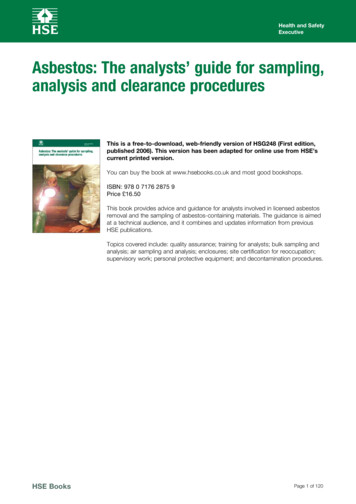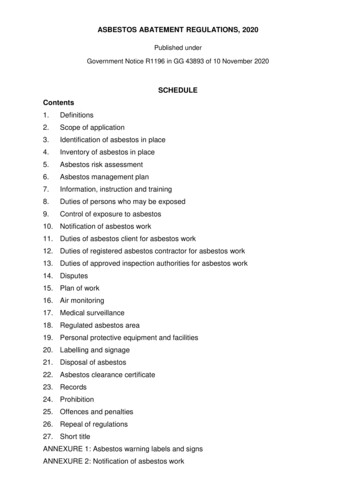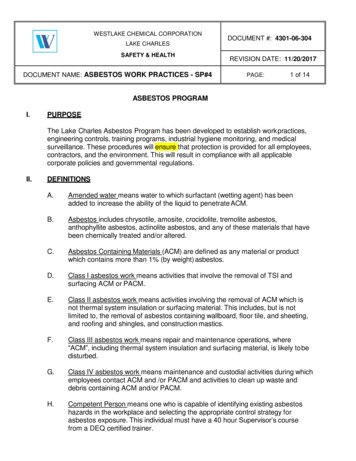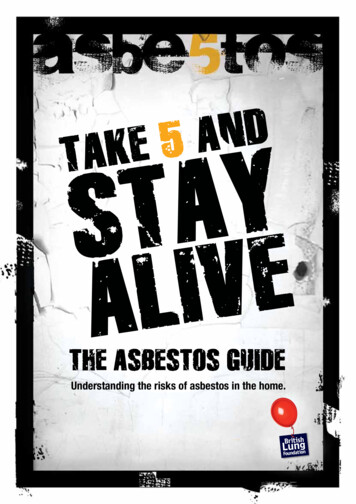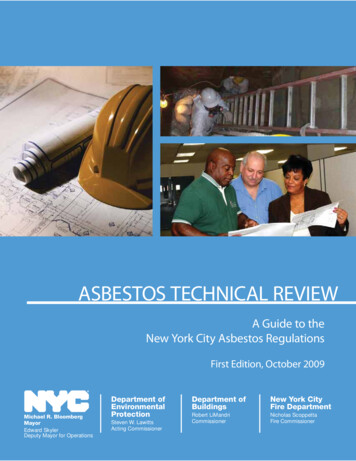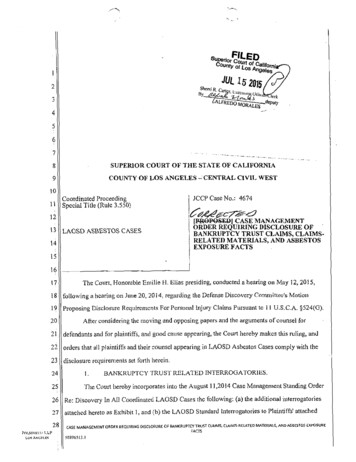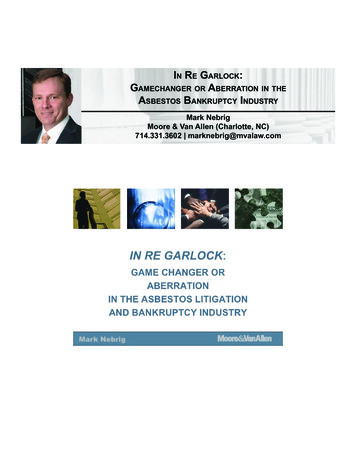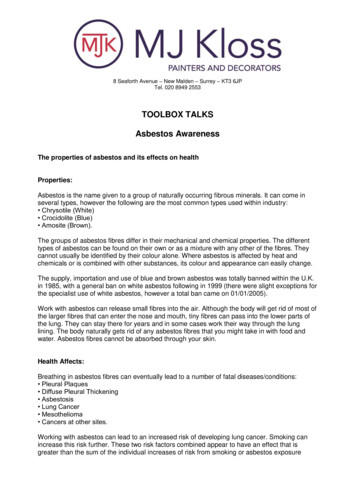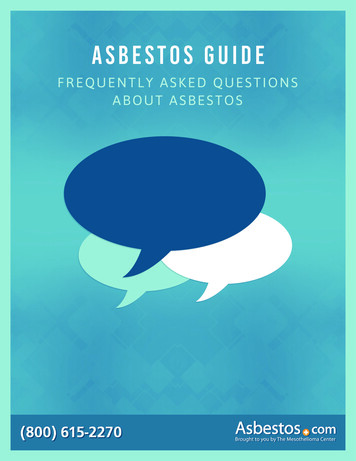
Transcription
WHAT IS ASBESTOS?WHAT CAN I DO ABOUT ASBESTOS IN MY HOME?I MAY HAVE BEEN EXPOSED TO ASBESTOS.HOW DO I GET TESTED?I WAS EXPOSED TO ASBESTOS, BUT MY TESTSCAME BACK NEGATIVE. WHAT CAN I DO?WHAT HAPPENS IF I VIOLATE ASBESTOS LAWS?HOW CAN I TELL IF A MATERIAL IN MY HOMECONTAINS ASBESTOS?DIAGRAM: ASBESTOS IN THE HOMEHOW MUCH DOES ASBESTOS TESTING COST?MORE IN-DEPTH INFORMATION
WHAT IS ASBESTOS?Asbestos is a naturally occurring toxicmineral known for its remarkablestrength and resistance to heat.Manufacturers have added asbestosto thousands of products to help withinsulation and fireproofing.It is most commonlyCementRoof ShinglesSteam PipesCeiling andFloor TilesTexturedPaintSpray-onInsulationfound in constructionmaterials used to buildmany older homes andpublic buildings,including:CLICK HERE to find more in-depth information about asbestos
WHAT CAN I DO ABOUT ASBESTOS IN MY HOME?If you think there is asbestos in your home, don't touch it.If the material is in good condition and will not bedisturbed, the best option is usually to leave it in place.If the material appears damaged or future activities coulddisturb it, contact a trained and accredited asbestosprofessional. Limit access to the area until a professionalcan confirm the presence of asbestos.CLICK HERE for more information about managing asbestos
I MAY HAVE BEEN EXPOSED TO ASBESTOS.HOW DO I GET TESTED?If you are concerned about apossible exposure to asbestos,start by talking to your primary-care physician.While no test can detectasbestos fibers in your lungs,your doctor can order imagingscans that reveal signs ofasbestos-related disease.CLICK HERE to find out more about getting tested
I WAS EXPOSED TO ASBESTOS, BUT MYTESTS CAME BACK NEGATIVE. WHAT CAN I DO?Asbestos-related conditions are difficult to detect, and not allprimary care doctors have the tools and experience todiagnose them.It’s always a good idea to seeka second opinion from a qualifiedlung specialist, such as an occupationalpulmonologist. Even if further testscome back negative, monitor yoursymptoms and get re-tested annually.Most asbestos-related diseases arediagnosed at least 15 years after exposure.CLICK HERE to find out more about monitoring your health
HOW CAN I TELL IF A MATERIAL IN MY HOMECONTAINS ASBESTOS? (CONT.)Asbestos use hasdeclined significantlysince the late 1970s,when the U.S. bannedspray-on asbestos andseveral other uses.However, many olderhomes still containasbestos hazards.A. Exterior Surfaces1. Roof Felt and Shingles2. Window Putty3. Cement Abestos Board Siding/UndersheetingB. Insulation1. Vermiculite Insulation2. Batt InsulationC. Flooring1. Vinyl Asbestos Floor Tile Interior Surfaces1. Popcorn/Sprayed-on Ceilings2. Textured PaintE. Boilers, Heating & Piping1. Heat Source Covering2. Door Gaskets3. Duct Linings4. Wall Gaskets and Linings(!I Electrical Equipment1. Recessed Lighting2. Wiring Insulation3. Fuse Boxes4. OutletsG. Appliances1. Refrigerators/Freezers2. Range Hoods3. Woodstoves {Heat Reflectors)4. Clothes DryersNot Shown: Dishwasters, Toasters,Slow ookers, Portable Heaters,Hair DryersH. I Miscellaneous1. Fireplace LogsJ.Automotive1. Brake Linings, Gaskets andClutch FacingsCLICK HERE for more information about identifying asbestos
HOW CAN I TELL IF A MATERIAL IN MY HOMECONTAINS ASBESTOS?collectSearch for “asbestos inspection” online or in the phone book to find alicensed expert.You may also want to look up ‘OntarioReg. 278/05:DESIGNATED SUBSTANCE
HOW MUCH DOES ASBESTOS TESTING COST?You can hire a professional to inspect yourhome and collect samples, or you can do ityourself with a test kit from your localhardware store. The cost of asbestos testingvaries depending on the number of samplestested and the methods used.The most popular testing method, PolarizedLight Microscopy (PLM). Some labs useTransmission Electron Microscopy (TEM) whichis more expensive. DIY test kits requireyou to mailsamples to an accredited lab, whichmay chargean additional fee for analysis.Collecting samples yourself can create exposure risks,so hiring a certified professional is the safest choice foryou and your family.
MORE IN-DEPTH INFORMATIONWhat Is Asbestos?Asbestos is any of several naturally occurring minerals composed of long, thincrystal fibers. The material has many desirable qualities, including impressiveresistance to heat, flame, electricity andchemicals. Because of these properties,a wide range of industries used asbestosto strengthen, insulate and fireprooftheir products.Around the late 1800s, manufacturersbegan adding asbestos to industrial,construction and household products.The material became a commoningredient in cement, bricks, roofingmaterials, pipe coatings, heating systeminsulation, gaskets, brake pads andthousands of other products.In the decades that followed, healthexperts found increasing evidence thatbreathing airborne asbestos can causea variety of serious lung conditions,including several cancers. While manyuses for asbestos were phased out, itremains legal in the U.S. for more thana dozen applications.CementPipeCoatingsBricksHeating SystemInsulationRoofingMaterialsBrakePadsCLICK HERE to return to frequently asked questions
MORE IN-DEPTH INFORMATIONAsbestos-Related Health RisksStudies have linked more than a dozen diseases to asbestos exposure. Several ofthese conditions, such as mesothelioma, asbestosis and lung cancer, have a confirmedrelationship with the toxic mineral. Others, such as COPD and kidney cancer, are notdirectly caused by asbestos, but researchers suspect exposure can increase a person’srisk for developing them. The risk for lung cancer is especially high for smokers whoare exposed to asbestos.Today, asbestos remains in many homes built between 1930and the late 1970s, and in approximately 132,000 primaryand secondary schools across the country. When asbestoshazards aren't handled properly, building renovations,demolitions and simple home repairs can lead to serioushealth risks.How Does Asbestos Exposure Occur?Asbestos exposure often happens when people disturb asbestos-containing productswith activities like sawing, sanding, drilling or scraping. Asbestos-containing materialspose minimal health risks when in good condition, but they can release toxic fibersinto the air when they start to deteriorate or become damaged.Breathing or swallowing airborne asbestos won't cause any immediate harm, butmicroscopic asbestos fibers tend to build up in the lungs and cause inflammation andscarring over time. It can take decades — typically between 20 and 50 years — fordiseases like asbestosis, lung cancer and mesothelioma to arise after the firstexposure to asbestos. The likelihood of a person developing an asbestos-relateddisease varies depending on the duration and intensity of exposure.CLICK HERE to return to frequently asked questions
MORE IN-DEPTH INFORMATIONTesting for AsbestosThe only way to confirm the presence of asbestos ina material is to have it tested at a certifiedlaboratory. For the safety of you and your family,only a qualified professional should collect samplesfor analysis. The EPA only recommends testing amaterial for asbestos if it is damaged or could bedisturbed by renovations or other activities.It is crucial you find out if asbestos is present beforeyou perform maintenance or have your houseremodeled. Don't touch any potential asbestosVarious householdmaterials, but be sure to look for any wear and tearasbestos products,or water damage. If you find asbestos materials inincluding asbestospoor condition, or if you plan to make changes tocement pipe, ayour home that may disturb them, you will need tohire an asbestos professional to have it concealed orsafely removed.corrugated asbestospanel and asbestosterrazzo floor.Avoiding Harmful ExposuresThe best way to avoid asbestos exposure is to be knowledgeable about the asbestosmaterials in your home, including their locations and current condition. Limit anyactivities in areas with asbestos — especially if the materials are falling apart.CLICK HERE to return to frequently asked questions
MORE IN-DEPTH INFORMATIONHow to Spot Asbestos in the HomeClick to EnlargeIf your home was built between 1930 and 1977, there'sa good chance it contains asbestos materials in one ormore locations. Asbestos insulation was highly commonbetween 1930 and 1950. From the 1920s to 1990, abrownish-gold colored wall and attic insulation calledvermiculite was often contaminated with asbestos. Thediagram to the right shows many areas where asbestos··--- - . '·-.l·rCC·Mproducts can be found around the home.VinylAsbestos sbestosRoof TilesAsbestosCement WallSidingUnless a product or material is clearly labeled - and few were - there is no way totell whether or not it contains asbestos just by looking at it. If you think a productin your home contains asbestos, it is suggested that you treat it as if it does, andleave it alone.CLICK HERE to return to frequently asked questions-----------------------}
MORE IN-DEPTH INFORMATIONAsbestos Safety Do's and Don'tsIf you own an older home, take every precaution to avoid damaging materials thatmay contain asbestos. Even if a repair seems minor, you should hire a professional ifasbestos may be present. Improper handling of safely managed asbestos can createan exposure risk where there was none before.Do:Avoid any contact withdangerous asbestos materials.Talk to your home inspector or realestate agent about any knownasbestos risks in your home.Take every precaution not todamage any materials thatmay contain asbestos.Only hire trained professionals forasbestos inspections, testing, repairsor removal.Don't:xxxxxxDon't saw, sand, scrape, drill or disturb materials that may contain asbestos.Don't sweep, vacuum or dust debris that may contain asbestos.Don't collect asbestos samples for testing without proper training.Don't perform any work on or near asbestos materials unless you're trained andcertified.Don't remove asbestos unless repair or concealment is impossible, and there's ahigh risk for exposure.Don't dispose of asbestos materials with normal household waste.CLICK HERE to return to frequently asked questions
MORE IN-DEPTH INFORMATIONCommon Exposure ScenariosWhile remodeling the attic of his 1960s home, John found piles ofbrown pebble-like insulation. He decided to replace the existinginsulation with new fiberglass insulation to save money in thewinter months. He scooped the loose insulation into some garbagebags and installed the new material.How John was exposed: John had no idea that his attic was insulated withvermiculite, which was contaminated with asbestos for decades. By disturbing thematerial, he spread airborne asbestos fibers. John should have left the insulationalone and had it tested for asbestos before disturbing it.Ralph is an aspiring gearhead who loves working on his 1965Corvette Stingray. When his brakes started to squeal, Ralph wantedto try replacing them in his own garage. After removing the reartires, however, he saw the brake drums were covered in dust. To clean them off, hebanged the sides with a hammer and blew the dust away with an air compressor.How Ralph was exposed: Because some brake components contain asbestos,spraying them with compressed air can release toxic fibers into the air. Ralph shouldhave taken his car to the shop for service, or wiped down the brake drums gentlywith a wet cloth.CLICK HERE to return to frequently asked questions
MORE IN-DEPTH INFORMATIONCommon Exposure Scenarios (Cont.)Erica recently won a painting at a silent auction and couldn't wait tobring it home and hang it in her living room. She measured carefullyand used a drill to install drywall anchors to keep the painting inplace. The painting wasn't level, however, so she had to drill a few more holes beforeit hung perfectly.How Erica was exposed: Erica had no idea that her home was built withasbestos-containing drywall. When she drilled through the wall to hang her painting,asbestos fibers from the drywall escaped into her living room. Erica should haveknown about the asbestos in her walls and left it alone.Herman just purchased a 1950s fixer-upper in his home town, andhis first project was upgrading the master bathroom. He decided tostart by removing the hideous vinyl floor tile. He removed theexisting tiles with a scraper and installed the new tile when he was done.How Herman was exposed: Asbestos was a common ingredient in vinyl floor tiles inthe 1950s. Using a scraper to remove the old flooring can release dangerous asbestosfibers. Herman should have left the old tiles alone and installed the new tile over it.CLICK HERE to return to frequently asked questions
MORE IN-DEPTH INFORMATIONCommon Exposure Scenarios (Cont.)Janine was tired of the popcorn texture on the ceilings in herhome, so she decided to scrape it off and repaint with a smoothfinish. After putting on eye protection and a dust mask, shegrabbed her ladder and got to work. After lots of scraping, a little sanding and somecareful painting, she was finally done.How Janine was exposed: Many textured ceiling finishes, including popcorn ceilings,have concealed asbestos. Scraping off the popcorn finish released microscopicasbestos fibers that easily passed through Janine1 s dust mask. She should have hireda professional trained in safely removing asbestos hazards.'When fixing up the basement of his late-1800s Victorian home,Brent noticed that the insulation around some of the hot waterpipes was starting to deteriorate. Not wanting to lose any heatefficiency, he cut away the old insulation with a utility knife and replaced it with newfiberglass insulation.How Brent was exposed: Brent should have known that many older plumbingsystems are wrapped in asbestos insulation. The insulation may have already posedan exposure risk before he started the project, but cutting away the damagedmaterial released even more fibers into the air. Brent should have hired an asbestosprofessional to seal the asbestos insulation.CLICK HERE to return to frequently asked questions
MORE IN-DEPTH INFORMATIONExposed to Asbestos? Get Tested!If you think you were exposed to asbestos, don't panic.There are several proactive steps you can take toprotect your health. Not everyone who breathesairborne asbestos develops an asbestos-related disease.If you experienced a brief, one-time exposure, your riskfor cancer or another asbestos-related condition issmall.Keep in mind that it can take a long time for asbestos-related diseases to develop.Most people don't experience any signs or symptoms until 15 or more years afterexposure. Mesothelioma and lung cancer typically take between 20 and 50 years todevelop.What if you've been exposed to asbestos but don't have any symptoms?Start by scheduling an appointment with your primary care doctor. Be ready todiscuss any past exposures to asbestos, including where, when and for how longyou were exposed. No test can detect asbestos fibers in the lungs, but your doctorcan order a chest X-ray or another imaging scan to reveal signs of asbestos-relateddisease.If the tests show you are healthy, you need to monitor your health movingforward. Meet with your doctor every year to discuss your exposure, and find outif more testing is needed. See your doctor immediately if you start experiencingany new symptoms, such as shortness of breath, chest pain or a dry cough.CLICK HERE to return to frequently asked questions
MORE IN-DEPTH INFORMATIONSpecialists understand theintricacies of asbestos conditions that other physicians oftenmiss. Seeing a specialist increases the odds of an early diagnosis and prompt treatment,which are crucial for extending the life expectancy of cancer patients.How to Manage Asbestos RisksWhen you find a material in your home that may contain asbestos, the safest courseof action is to leave it alone and call a professional. Asbestos professionals aretrained and certified to manage asbestos risks safely. They can inspect your home,test materials for asbestos and advise you on how to deal with existing asbestos inyour home.There are several ways professionals can manage asbestos, including:No action: Leave low-risk asbestos in place and check its condition periodically.Maintenance: Perform minor repairs or activities that could result in exposure.Encapsulation: Enclose asbestos materials with spray sealant.Enclosure: Build a permanent air-tight barrier around the material.Abatement: Remove asbestos from the home.
MORE IN-DEPTH INFORMATIONIf the asbestos is still in good condition and you have no plans for activities that mightdisturb it, most experts will advise you to leave it in place. In many cases, removinglow-risk asbestos materials is more dangerous than managing them in place.asbestos work. Before hiring a company, ask for references from past clients.Sources:Agency for Toxic Substances and Disease Registry. (n.d.). Asbestos and Health: Frequently AskedQuestions. Retrieved from http://www.atsdr.cdc.gov/noa/docs/Asbestos%20FAQ ENG web.pdfNational Cancer Institute. (2009, May 1). Asbestos Exposure and Cancer Risk. Retrieved #q1U.S. Consumer Product Safety Commission. (n.d.). Asbestos In the Home. Retrieved -Guides/Home/Asbestos-In-The-Home/U.S. Environmental Protection Agency. (n.d.). Asbestos Frequently Asked Questions. Retrieved uments/asbestosfaqs 0.pdfU.S. Environmental Protection Agency. (2015, February 3). U.S. Federal Bans on Asbestos. Retrievedfrom tosU.S. Environmental Protection Agency. (2015, February 3). Protect Your Family. Retrieved ly#professionalsU.S. Environmental Protection Agency. (1990, December). Common Questions on the AsbestosNESHAP. Retrieved from key 50000M0R.PDF
including asbestos cement pipe, a corrugated asbestos panel and asbestos terrazzo floor. How to Spot Asbestos in the Home If your home was built between 1930 and 1977, there's . may contain asbestos. Even if a repair seems minor, you should hire a professional if asbestos may be present. Improper handling of safely managed asbestos can create
